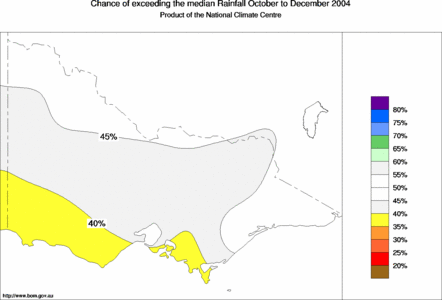Increased risk of dry conditions in parts of southern Victoria
There is a moderate shift in the odds towards below average rainfall
for the December quarter in parts of southern Victoria,
the Bureau of Meteorology announced today.
For the rest of the State, the chances of accumulating at least
average rain over the last three months of 2004 are mostly close to
50%.
Along the West Coast, parts of the Western Plains and in a small area in
south-central Victoria, the chances of above median rainfall for the
December quarter are between 35 and 40%. So in years with ocean patterns
like the current, about six October to December periods out of ten are
expected to be drier than average in these areas, with about four out of ten being wetter.

Furthermore, when looking at the growing season (April-November) as a
whole over southern and eastern Australia, widespread below to very
much below average falls up to the end of August mean that many places
are unlikely to reach their total growing seasonal average by the end
of November. The chances of receiving the required rain are
below 20% over much of the Mallee, Wimmera and Northern Country. For more
information on the recent dry conditions, see the Drought Statement.
The current pattern of outlook probabilities is due to recent temperature
patterns in both the Pacific and Indian Oceans.
Outlook confidence is related to the influence of Pacific and Indian
Ocean temperatures on seasonal rainfall. During the December quarter,
history shows this influence to be moderately consistent across much
of Victoria (see background information).
The chance of a late-developing El Niño event increased over the past month,
with several but not all indicators reaching their El Ni˜o thresholds.
The mounting evidence includes
warming of the central Pacific, reduced Trade Winds in the same area
and continued negative values of the Southern Oscillation Index (SOI)
which came in at –8 for August. The approximate SOI for the 30 days
ending 13th September was –3.
For routine updates on the latest data relating to El Niño, together
with details on what the phenomenon is and how it has affected
Australia in the past, see the El Niño Wrap-Up.
|